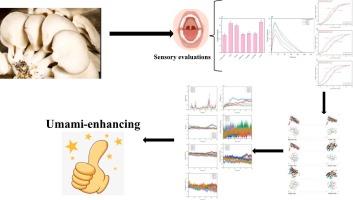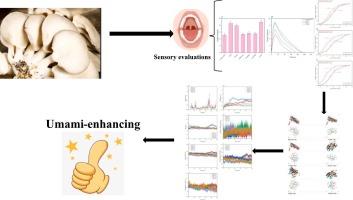通过虚拟筛选、感官评价和分子模拟等方法鉴定平菇新型鲜味肽及其增味效果
IF 9.8
1区 农林科学
Q1 CHEMISTRY, APPLIED
引用次数: 0
摘要
本研究鉴定了从平菇中提取的鲜味增强肽,并通过分子模拟阐明了它们的相互作用机制。我们通过全面的虚拟筛选过程确定了六个具有潜在鲜味增强特性的候选肽。感官评价显示,这些鲜味肽的味道特征各不相同,检测阈值为0.05 ~ 0.17 mmol/L。三种鲜味增强肽(DRAFR、LDFR和VLRDF)在3 mg/mL味精(MSG)溶液中显著增强鲜味的强度和持续时间,表现出协同或加性效应。分子对接表明,三种鲜味增强肽主要通过氢键与鲜味受体结合,确定了关键的相互作用位点,如Asp218、Asp108、Cys50、Gly49、Arg151、Arg357和Leu308。随后的分子动力学模拟证实鲜味受体和鲜味增强肽之间形成了稳定的复合物,验证了它们调节鲜味感知的潜力。这些结果为平菇增味肽的筛选和新型增味调味品的开发提供了理论依据。本文章由计算机程序翻译,如有差异,请以英文原文为准。


Identification of novel umami peptides from Pleurotus ostreatus and their umami-enhancing effects through virtual screening, sensory evaluation, and molecular simulation
This investigation identified umami-enhancing peptides derived from Pleurotus ostreatus and elucidated their interaction mechanisms via molecular simulations. We identified six peptide candidates with potential umami-enhancing properties through a comprehensive virtual screening process. Sensory evaluations revealed that these umami peptides vary in taste characteristics, with detection thresholds ranging from 0.05 to 0.17 mmol/L. Three umami-enhancing peptides (DRAFR, LDFR, and VLRDF) were found to significantly enhance both the intensity and duration of umami in a 3 mg/mL monosodium glutamate (MSG) solution, demonstrating synergistic or additive effects. Molecular docking demonstrated that three umami-enhancing peptides primarily engaged with umami taste receptors through hydrogen bonds, pinpointing critical interaction sites such as Asp218, Asp108, Cys50, Gly49, Arg151, Arg357, and Leu308. Subsequent molecular dynamics simulations confirmed the formation of stable complexes between umami receptors and umami-enhancing peptides, validating their potential to modulate umami perception. These results provided a theoretical basis for umami-enhancing peptides peptide screening and the development of novel umami-enhancing seasonings derived from Pleurotus ostreatus.
求助全文
通过发布文献求助,成功后即可免费获取论文全文。
去求助
来源期刊

Food Chemistry
工程技术-食品科技
CiteScore
16.30
自引率
10.20%
发文量
3130
审稿时长
122 days
期刊介绍:
Food Chemistry publishes original research papers dealing with the advancement of the chemistry and biochemistry of foods or the analytical methods/ approach used. All papers should focus on the novelty of the research carried out.
 求助内容:
求助内容: 应助结果提醒方式:
应助结果提醒方式:


